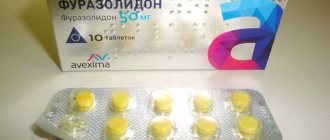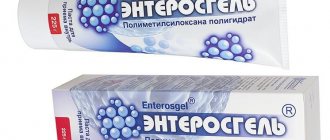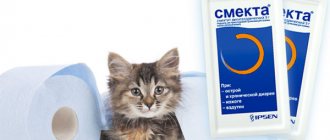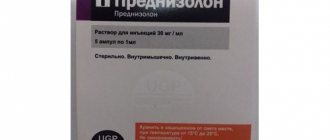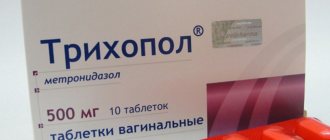Medicines for animals > Furazolidone (tablets)
Brief description:
Furazolidone is a drug that belongs to the nitrofuran group and has extensive antimicrobial effects on gram-positive and gram-negative bacteria. The undoubted advantage of the drug is that microorganisms very slowly develop resistance to the substance, while it remains very insignificant. The antibacterial effect of the drug is a hundred times greater than furatsilin, while being less toxic. The product is capable of destroying even antibiotic- and sulfonamide-resistant organisms.
Indications for the use of the drug are various diseases caused by bacterial infections, such as salmonellosis, colibacillosis, coccidiosis, balantidiasis, enteritis, hepatitis and others.
For whom:
most often used in veterinary medicine for the prevention and treatment of infectious diseases of farm animals - cattle, pigs, poultry, as well as intestinal infections of dogs and cats.
Leave form:
The drug is produced in the form of round tablets of yellow color, odorless, slightly bitter taste, with an active ingredient content of 0.05 g. Tablets of 10 pieces are packaged in contoured cell-free or cell packaging, which, together with instructions for use of the product, are placed in 2 pieces each labeled cardboard box.
Dosage:
Depending on the type of animal and the type of disease, there are many individual treatment regimens with specifically selected dosages of the drug. It can only be prescribed by a veterinarian observing a sick animal.
The most common general regimen for the use of Furazolidone in livestock is as follows. The daily dose of the medicine must be mixed with food or water, divided into three equal parts and fed with an interval of 4-6 hours.
For gastrointestinal disorders in dogs and cats, the dosage of the substance depends on the weight of the animal. For example, for a large dog the daily norm is 0.15 g, which is divided into three doses (1 tablet 0.05 g three times a day).
Restrictions:
Side effects from Furazolidone can develop with its long-term use in large doses. There may be cases of manifestations of such specific conditions as neuronephritis, toxic liver dystrophy, polyneuritis, and allergic reactions are possible. It is not recommended to use the drug on weakened animals in the spring.
The use of the medicine for pregnant animals is prohibited.
Pharmacodynamics and pharmacokinetics
Pharmacodynamics
Furazolidone is an antimicrobial agent derived from nitrofuran. Salmonella, Shigella, Campylobacter, as well as protozoa (Gardia, Trichomonas) and Vibrio cholerae are highly sensitive to it. Depending on the concentration, it has a bactericidal or bacteriostatic effect.
The mechanism of action is the blockade of many enzyme systems of the microorganism. Nitrofurans disrupt cellular respiration, suppress the Krebs cycle and block the biosynthesis of nucleic acids. As a result, the shell of microorganisms or their cytoplasmic membrane is destroyed. When the drug acts, destroyed microbial cells release less toxins. Unlike other antimicrobial agents, they activate the immune system.
We suggest you read: Cow anatomy interesting features
Acts on strains resistant to some antibiotics. Does not affect anaerobes and Pseudomonas aeruginosa. Resistance of microorganisms to the drug occurs rarely.
What is Furazolidone used for? Since it is poorly absorbed from the gastrointestinal tract and high concentrations are created in the intestine, it is used for intestinal infections of bacterial and protozoal etiology. Unlike Furadonin, it is characterized by low toxicity.
Pharmacokinetics
Well absorbed when taken orally. Distributed in tissues and liquids. In the cerebrospinal fluid during meningitis, the same concentrations are created as in the plasma; therapeutic concentrations are also achieved in the intestinal lumen. Intensively metabolized in the liver to an inactive metabolite. Excreted by the kidneys (up to 65%), small amounts are determined in feces,
How to give Furazolidone to a dog if it has diarrhea
Furazolidone has been used in dogs for a long time in the treatment of all kinds of gastrointestinal disorders associated with infections and poisoning. With the rapid development of the pharmaceutical industry in recent decades, many new drugs have appeared, but the relevance of furazolidone remains at a high level even now, especially in veterinary medicine.
Signs of the disease:
- gastrointestinal disorder;
- diarrhea or diarrhea;
- nausea, vomiting;
- lethargy, weakness;
- refusal to eat.
Furazolidone belongs to the group of nitrofurans that have a strong bactericidal effect. This effect is achieved due to the acceptor properties in relation to oxygen, while in microbial cells under conditions of lack of oxygen, the processes of oxidation-reduction and synthesis of nucleic acids stop, as a result of which the cells die.
Owner reviews
Breeders and animal owners quite often use furazolidone for their pets. According to them, this life-saving medicine is remarkably helpful for gastrointestinal disorders. The bad thing in this situation is that, while giving 1-2 tablets and seeing the effect, the owners do not complete the course of treatment.
The price of the drug also attracts owners: “excellent effect for pennies.”
Veterinarians of the old generation still quite often recommend furazolidone to piglets and calves, puppies and chickens, but young veterinarians prefer an antibiotic, for example, chloramphenicol, the spectrum of action of which is many times wider, and it affects the same forms of microorganisms and protozoa.
Furazolidone is a drug of the last century; it is being replaced by new, highly effective drugs. Science and the pharmaceutical industry are constantly developing drugs with “high precision of hitting” the microflora that causes harm. It is possible not to use the developments of scientists and practitioners in the modern world, but it is necessary to take into account that microorganisms also mutate, and science is trying to catch up with them, and sometimes even get ahead of them.
Pharmacological properties
Furazolidone has a slow-acting type, its absorption occurs through the stomach and intestines within 14–16 hours, as it enters the blood, within an hour, it begins its effect, and after two hours the bacteriostatic concentration of furazolidone is achieved, which is maintained for 12 hours .
At the same time, furazolidone is almost non-addictive, has no toxic effect on the body, and is excreted by the kidneys and through the gastrointestinal tract within 1 to 2 days. This makes the drug in demand in veterinary medicine to this day, especially in the treatment of young farm animals and domestic animals.
Furazolidone effectively suppresses many, both gram-positive and gram-negative microorganisms, the appearance of which causes various gastrointestinal disorders. These are the following pathogens:
- streptococcus;
- Pneumococcus;
- staphylococcus;
- salmonella;
- Proteus;
- Escherichia;
- Giardia;
- coccidia;
- fungi of the genus Candida, etc.
The drug is especially valuable in case of mass infection of animals; in combination with antibiotics, it helps to successfully stop the spread of infection. This applies to nurseries and animal shelters. In addition to the therapeutic effect, furazolidone has a general strengthening effect on the body - an increase in the amount of hemoglobin, total protein and creatinine in the blood.
Furazolidone remains the preferred antimicrobial agent in veterinary medicine due to its properties:
- quick access to the infected area;
- duration of action;
- good compatibility with other drugs;
- no significant toxicity.
Furazolidone appears to be more active in its antimicrobial action in many cases than chloramphenicol, chlortetracycline and streptomycin.
Release form of the drug
Furazolidone is a yellow, odorless powder with a bitter taste. Available in powder form (packaging 2.5 kg, 1 kg, 100 g, 500 g) and in tablets containing the active substance 0.05 g (that is, 50 mg).
Instructions for the drug furazolidone
Furazolidone for diarrhea (for large breed dogs) is recommended to take 1 tablet 3 times a day for 4-6 days, depending on the condition of the dog.
Furazolidone for puppies (as well as for kittens) for a single dose is calculated at 3-5 mg/1 kg of animal weight.
Sometimes a longer duration of treatment is required, up to 10 days, but this is not recommended. Also, an overdose should not be used, since the bacterioscopic effect of furazolidone is effective in small doses, and its excess will be unproductively deposited in the body tissues in the form of metabolites (decomposition products) that cause side effects.
Contraindications:
- pregnancy;
- lactation period;
- hypersensitivity to the drug.
Storage:
- with caution, list B;
- temperature from 5 to 25 o C;
- in a dry place;
- without access to light;
- Shelf life is 5 years from the date of manufacture (indicated on the packaging) if all storage rules are observed.
Side effects and overdose
An overdose causes toxic hepatitis, polyneuritis and has a hematotoxic effect. There is no antidote, so symptomatic treatment is used.
The drug is taken orally, after meals, as it can cause dyspeptic disorders. The tablets should be taken with a glass of water. With long-term use to prevent neuritis, it is combined with taking B vitamins.
The dose for adults for paratyphoid fever, dysentery and food poisoning is 0.1 g per day 4 times a day for 5–10 days. Single dose - 0.2 g, daily dose - 0.8 g.
For giardiasis - 0.1 g 4 times a day for up to 7 days, after a week the same course is repeated.
For trichomonas urethritis - 0.1 g 4 times for 3 days.
For trichomonas colpitis, the dosage and frequency of administration are the same and in parallel, a powder containing furazolidone milk sugar is injected into the vagina, and suppositories containing 4-5 mg of furazolidone are administered into the rectum.
For the treatment of burns locally in the form of bandages with a solution of the drug (1:25000).
For children, the dose is calculated per kg of body weight. It is: one-time - 0.0025 g per kg, and daily 0.01 g per kg, distributed over 3-4 doses. The course of treatment is 5-7 days.
The veterinary drug is a yellow powder, insoluble in water.
The drug is used for salmonellosis, coccidiosis, colibacillosis, enteritis, balantidiasis in animals and birds. You can also use a pharmaceutical drug in tablets (one tablet contains 50 mg).
The dosage for these diseases is the same for chickens, turkey poults and broilers - the drug is added to the feed at the rate of 3 mg per head 2 times a day, treatment is carried out for 8 days. If necessary, the course of treatment is repeated, but after a break of 10 days. As a preventative measure, young animals up to 10 days of age are given 2 mg per head once a day.
An overdose is unacceptable, since the bird becomes drowsy, lethargic and may die. How to feed to chickens? Better with food. Another option is to dissolve it in water and give it as a drink. But you need to know that the drug does not dissolve well and loses its properties when exposed to sunlight.
Manifests itself as toxic hepatitis, polyneuritis and changes in the blood.
Treatment consists of discontinuing the drug, prescribing antihistamines and B vitamins, and drinking plenty of fluids.
The doctor selects the dosage depending on the general condition of the patient and the bacteria that caused the diarrhea. This is logical: ordinary food poisoning requires one approach, but life-threatening typhoid or cholera requires a completely different one. Therefore, the dosage described below has only general, average values.
If the drug is prescribed for an adult, then 100-150 grams of the product (2-3 tablets) should be taken. For children over 5 years of age, the permissible dose is 25-50 grams (0.5-1 tablet). For a child from 1 year to 5 years, the dosage is calculated depending on body weight: 10 mg of medication per 1 kg of weight. You need to take the medicine 3-4 times a day.
The course of treatment lasts from 5 to 10 days. However, if no positive effect was detected on the second or third day, it means that diarrhea is most likely caused by bacteria that are insensitive to this antibiotic. You should consult your doctor to clarify the diagnosis and change the drug.
If you missed a dose of the drug (and this happens when the disease recedes), you should immediately take the forgotten dose. If the omission was noticed when it was time to take the next tablet, there is no need to double the dosage. You should not adjust the dosage yourself: if sudden changes occur in your health, you should consult your doctor about changing the treatment regimen. If there are no other doctor’s recommendations, be sure to complete the therapeutic course to the end.
While treating a child with an antibiotic, you need to monitor his behavior and well-being in order to promptly notice allergic reactions and other side effects and prevent their development.
When using Furazolidone to treat diarrhea, it is important to adhere to the diet and drinking regimen. It is necessary to drink at least 3 liters of clean (non-alkaline) water - this will help avoid dehydration. When weakened, you can drink strong sweet tea. For the entire period of taking the drug, you should completely avoid cheeses, smoked foods, legumes, canned and pickled vegetables - this will help reduce the risk of adverse reactions.
While taking the drug, the color of the urine may change - in this case, this is a type of normal that does not require additional treatment.
Possible undesirable effects of taking Furazolidone for diarrhea include:
- sudden loss of appetite, anorexia;
- tachycardia, increased blood pressure;
- headache;
- cough, bronchospasm, chest pain;
- unexpected increase in symptoms of poisoning (nausea, vomiting and diarrhea);
- allergies (redness, itching);
- lethargy, slow reaction;
- exacerbation of depression in those who are prone to this disease.
To reduce the number of side effects, along with the antibiotic, the doctor prescribes a course of vitamin B and lactobacilli.
If the dosage is exceeded, Furazolidone can cause hematotoxicity (negative effects on blood cells, their functionality and quantity), toxic hepatitis (destruction of liver cells), polyneuritis (damage to nerve fibers).
Furazolidone is prescribed when the gastrointestinal tract experiences some problems in its functioning as a result of infection. This antimicrobial drug should be used only after detecting the following symptoms of poisoning:
- nausea and vomiting;
- diarrhea;
- stomach and intestinal cramps;
- increased body temperature;
- headache.
We suggest you read: Why do cats love to lie on their backs?
The tablets are taken strictly in accordance with the dose, since the occurrence of unwanted side effects is possible.
The medicine is taken orally, after meals. The course of therapy is prescribed by doctors for each patient individually.
For an adult
The use of Furazolidone for diarrhea requires strict adherence to all recommendations. Each disease has its own dosage to treat. After completing the course, it is necessary to take tests to determine the effectiveness of therapy.
The manufacturer of the drug advises adults to take two tablets at equal intervals. Visiting hours should not be changed.
For dysentery, the doctor prescribes a course of therapy for a period of 7 to 10 days. Take no more than 3 tablets 4 times a day (every 6 hours).
Furazolidone for poisoning (alcohol, food) is used depending on the severity of the disease. As a rule, treatment is carried out no longer than 1 week. The tablets are also taken in 3-day cycles. In accordance with the instructions, the dose of the medicine is 100 mg up to 4 times a day after meals. In total, you can drink 800 mg per day. The weight of one capsule is 50 mg.
For a child
When the first signs of illness are detected in children, you should not immediately give Furazolidone anti-diarrhea tablets. First you need to visit a pediatrician and get an examination. The doctor prescribes this drug if one of the following infections is confirmed:
- dysentery;
- paratyphoid;
- food poisoning;
- giardiasis;
- rod or coccal.
When furazolidone is prescribed for diarrhea, it is difficult for children under 5 years of age to swallow unchewed tablets. Therefore, preparing a suspension is the right solution in such cases. It is obtained from granules that are diluted with warm water.
The severity of the infectious disease helps determine what dose to prescribe to a sick child. Furazolidone for diarrhea is given up to 4 times in a maximum of one day. The dosage is calculated - per 1 kg of baby's weight - 6-7 mg of the drug.
At the same time, doctors prescribe B vitamins, medications that restore weakened immunity, as well as tablets to remove toxins from the body.
Furazolidone is prescribed to children in small dosages. In tablets for intestinal infections, the concentration of the compound must be observed for each age:
- If the child is under 3 years old, half a tablet or 5 ml of suspension is given for oral administration at the same time - 8 hours, i.e. no more than 3 times a day.
- Children under 12 years of age are allowed to take one tablet 3 times a day.
- For adolescents from 12 years of age, the dosage increases. Take 75 mg (1.5 tablets) up to 4 times a day (every six hours).
Pregnant
Furazolidone is contraindicated for use during pregnancy.
Furazolidone in veterinary medicine
In veterinary practice, furazolidone is used not only for dogs and cats, but also for agricultural livestock, birds and fish for all kinds of infectious diseases.
The following dosages of furazolidone are used:
- 4-5 mg/kg body weight – for calves;
- 10 mg/kg body weight – piglets;
- 2.5-3 mg/kg body weight – for chickens;
- 1-2 g / 10 kg of food - carp (for rubella).
The meat of animals treated with furazolidone is suitable for people to eat no earlier than 4 days after the end of taking the drug, but if earlier than 4 days, it is used only for animal feed and for preparing meat and bone meal.
Milk from animals is prohibited from being used for food during the entire period of treatment and 2 days after the last dose; it is used only for feeding animals.
Causes of diarrhea in dogs
It is not recommended to treat a dog or any other animal without first consulting a veterinarian, so as not to cause irreparable harm to the animal through your actions.
It must be remembered that diarrhea in a dog can be for various reasons and does not always require immediate initiation of drug therapy, but is often eliminated within a few hours by eliminating the cause that caused it.
If diarrhea occurs in a dog, you need to find out the cause of it in order to approach treatment competently and not harm the dog through illiterate actions. The approach to treatment is different. Causes of diarrhea in dogs can be:
- Poor nutrition or spoiled food, individual intolerance to components (allergies, indigestion). In this case, the cause can be eliminated by simply replacing the food;
- Poor water quality and sudden changes in feed, for example from dry to canned. In this case, you need to first test on a small portion of food and wait for the dog’s body to react. This way you can carefully select the right food for your dog;
- Parasites in a dog's intestines are a very common cause of diarrhea in dogs. Helminths are difficult to see and recognize with the naked eye; this requires a stool test for helminth eggs. Regular preventive treatment of dogs for helminths is recommended (every few months), which will help eliminate this cause altogether;
- Having been vaccinated the day before, the dog may develop a complex reaction to the administered vaccine. Everything goes away on its own, but if it happens again, you need to contact a veterinarian for advice;
- A pregnant dog may have toxicosis at an early stage, accompanied by vomiting and diarrhea. You cannot leave the situation to chance, in order to prevent dehydration of the body, which will lead to a miscarriage. You need to change your diet and introduce more fiber into it;
- After childbirth, diarrhea can be caused by afterbirth eaten by the dog. Cow's milk is also a laxative for the intestines;
- Acute diarrhea occurs when bacteria become infected through water or food. In this case, the dog requires antimicrobial therapy using furazolidone and antibiotics;
- Viral infection is a very serious threat to dogs, causing severe distress. Pathogens: canine distemper, coronavirus, parvovirus. It will not be possible to cure it on your own, you need to urgently take the dog to the clinic, it can be fatal;
- Side effects of drugs that were used in the near future. Read the instructions and choose another medicine;
- Fungi and protozoa (giardia, trichomonas) require special treatment;
- Tumors;
- Dysbacteriosis, vitamin deficiency, metabolic disorders - it is necessary to restore normal intestinal microflora with the use of lactic acid products or drugs;
- Mechanical injuries to the intestines due to foreign objects - they must be removed;
- Stress – when moving, when losing or changing the owner, etc. A quiet regime and gentle dietary feed are required.
In the case of diarrhea in dogs, you should always pay attention to the type, color and consistency of the stool, which can indicate the causes of diarrhea:
- green stool - indicates rotten food;
- white color is a sign of a biliary tract problem;
- yellow diarrhea – simple indigestion;
- orange tint – acute process in the liver;
- dark, black diarrhea – the presence of bleeding in the intestines, it requires immediate investigation;
- bloody diarrhea is always dangerous, a consequence of salmonellosis, leptospirosis, atypical rabies, damage to the intestines by a bone or foreign object, as well as chemical poisoning;
- diarrhea with mucus - often occurs during treatment for worms, when they come out in the form of mucus at the stage of digestion, as well as with disease of the large intestine;
- diarrhea with blood and mucus - you need to examine the stool for protozoa and worms, blood for biochemical analysis, to rule out intestinal ruptures.
A set of therapeutic measures for uncomplicated diarrhea in dogs
Diarrhea in dogs can be one-time or repeated over several days, followed by normalization of stool. This is not scary, but it requires careful monitoring of the dog’s condition and simple assistance to it on your own. If, in addition to diarrhea, mucus appears and a change in the color of the stool, vomiting and severe weakening of the animal due to dehydration are added, then you should immediately contact a veterinarian.
At the first signs of illness, it is important to analyze the diet the day before for poor quality foods, changes in the usual food and drinking water, and for the presence of overeating. Rule out stress, foreign bodies entering the dog’s intestines and other possible causes. If diarrhea continues after this, although without aggravating symptoms, the dog should be treated.
Sample treatment plan for uncomplicated diarrhea in dogs:
- You should not let your dog eat for 24 hours, but be sure to drink clean water frequently to replenish the water and electrolyte balance in the dog’s body;
- furazolidone 1 tablet x 3 times a day until diarrhea stops, for a maximum of 10 days (for more details, see the instructions for furazolidone);
- adsorbents (for example, activated carbon) to remove toxic poisons from the intestines;
- in case of very profuse diarrhea and vomiting, administer intravenous infusion solutions as prescribed by a veterinarian (saline solution, glucose, vitamins and others);
- for prolonged diarrhea, add antibiotics (chloramphenicol, streptomycin, chlortetracycline);
- If helminths are present, treat with anthelmintic drugs.
If complications occur, especially in puppies, you should not let the disease progress and promptly seek specialized help from a veterinary clinic.
Composition and form
Furazolidone is a drug containing biologically active substances that can slow down the reactions of the enzyme monoamine oxidase in nerve endings, which increases the blood levels of serotonin, norepinephrine, dopamine and other monoamines, which leads to a number of positive effects. But the most important effect is that Furazolidone exhibits antimicrobial properties .
The starting material for creating the drug is artificially derived nitrofurans. Pharmacological group: antimicrobial and disinfectants. The drug is prescribed to animals of any age with symptoms of infectious infection of the gastrointestinal tract and genitourinary organs, as well as for parasitic and microbial skin diseases. Often acts as an addition to already prescribed therapy.
Available in tablet form , each containing 50 milligrams of pure Furazolidone. Tablets are available in 10 pieces in a blister. It is also available in pill form, but it is not convenient for animals to take. You can find Furazolidone in powder form in plastic jars of various sizes. The latter form is preferable for animals, but it is difficult to obtain (rarely sold in pharmacies).
Piperazine
Piperazine is a highly effective, narrow-spectrum anthelmintic drug used against parasites in dogs and cats. Used to eliminate parasites classified as nematodes. Piperazine, intended for pets, comes in powder form that can be added to food, which greatly simplifies the process of feeding the medicine to your pet.
The pharmacological properties of the anthelmintic drug Piperazine are more than simple: when they enter the animal’s body, the active components of the drug paralyze the helminths, depriving them of the ability to move and attach to the walls of the internal organs of the digestive tract of a dog or cat. After some time has passed since taking the medicine, the parasites are eliminated naturally.
When treating cats and dogs for helminthic infestation with Piperazine, the dose should be as follows: 2 grams of powder for every ten kilograms of animal body weight. When using the product, it is recommended to destroy animal feces by burning. Otherwise, further spread of parasites cannot be ruled out.
Effect of the drug
Furazolidone is an antimicrobial agent, so it makes sense to use it only for diarrhea of bacterial etiology. An important positive difference between Furazolidone and other antibiotics is that it does not have a negative effect on the immune system. When used, the ability of leukocytes to destroy pathogenic microflora increases.
Furazolidone interferes with the biochemical processes of microorganisms, which as a result damages the cytoplasmic membrane of the bacterium. Already after 2-4 days of taking Furazolidone (even before the final destruction of microorganisms), a significant change in well-being is observed: the temperature drops, appetite returns, and sometimes the symptoms of diarrhea soften or disappear.
Does not show activity against pathogens of purulent anaerobic infection, and is also useless for viral infections (like any antibiotic). Many microorganisms develop slow resistance to this drug. Therefore, after 10-15 days of taking the drug, it must be replaced with another drug, with a different active ingredient.
The drug is quickly absorbed from the intestines. It is quickly absorbed by the liver, which subsequently leads to the formation of an amino derivative, a chemically inactive metabolite. When the central nervous system is inflamed, it quickly enters the cerebrospinal fluid, forming the concentration necessary for treatment. About 3⁄4 of furazolidone is excreted by the kidneys, a small percentage is found in excrement.
Effect of the drug on diarrhea
Furazolidone is prescribed to dogs for the treatment of diarrhea very often. This medicine belongs to the group of antimicrobial drugs that have a wide spectrum of action against various intestinal infections. Furazolidone helps a dog with diarrhea get rid of pathogenic flora; it is even active in the fight against staphylococcus. Due to its unique composition, it is given for enteritis and other gastrointestinal diseases, because it also has an anti-inflammatory effect. As an additional drug, Furazolidone is given to a puppy with diarrhea in the treatment of parasitic infestations.
The effect of taking the medicine is observed after two hours. The drug is not addictive and has no side effects, which makes the drug very popular in veterinary medicine. Like any antibiotic, Furazolidone affects the intestinal microflora, washing away positive microorganisms from the mucous membrane. That is why probiotics should be given to your pet in combination with this drug.
Furazolidone is not effective in dogs with fungal infections, tumors, diarrhea caused by injury to internal organs or bleeding in one of them. Another treatment is necessary, which can only be prescribed by a doctor after diagnosing a sick pet.
Things to remember
Let us immediately note one important circumstance. This drug belongs to the group of nitrofurans. These are antimicrobial drugs first synthesized at the beginning of the last century. Before the advent of antibiotics, they were widely used in both human and veterinary medicine. After antibiotics became widespread, they were usually used by veterinarians. And the point here is not only the obsolescence of this type of drugs and their low activity against most “modern” microorganisms (although this circumstance also plays a role).
The most unpleasant thing about these drugs is their side effects.
As a rule, dogs experience vomiting, increased thirst, and other signs of intoxication are possible . In addition, there is evidence that these drugs have a bad effect on the liver and kidneys of animals. Finally, when using furazolidone, there is a considerable risk of developing various allergic reactions : from simple urticaria to deadly Quincke's edema.
However, in some cases there is not much choice left. Firstly, nitrofurans have a completely destructive effect on many pathogenic microbes. Secondly, due to their chemical structure and a number of other features, resistance to these drugs (in microorganisms) develops very slowly. In addition, sometimes veterinarians and animal owners simply do not have other potent antimicrobial agents at hand, and treatment must be started urgently.
We emphasize that you should not prescribe or give this medicine to your pet yourself, even with severe diarrhea. First, it would not hurt to find out what exactly causes diarrhea. And for this you definitely need to seek help from a veterinarian.
When the medicine should not be used
The list of such cases is given below:
- Furazolidone should never be prescribed to animals with chronic renal failure, as well as to pets with acute and chronic liver and kidney diseases in the stage of decompensation.
- During pregnancy and lactation, the drug should be prescribed with extreme caution, and it is better to avoid such “experiments” altogether.
- It is strictly prohibited to give it to puppies under three months of age (in extreme cases, the animal must be at least a month old).
There is also information about individual intolerance to nitrofurans, but they are quite rare. Whether an animal belongs to the “lucky” group can be determined exclusively experimentally.
Dose for dogs
The recommended dosage is calculated based on the weight of the animal, and does not depend on the age of the pet. The puppy is given 10 mg/kg of the active substance per day, this dose should be divided into 3-4 portions and fed to the animal every 5-6 hours. The course of treatment is at least 5 days, but no more than 15 days, since in this case the microorganisms become addicted.
Restrictions on use
It is not recommended to give furazolidone to puppies under three months of age . It is strictly forbidden to give the drug to puppies under one month of age, as in this case there is a risk of liver and kidney damage. In addition, we must remember about individual intolerance to nitrofurans, which is often observed in young animals.
Important! The drug is contraindicated for kidney disease, any problems with the liver or nervous system.
Possible adverse reactions:
- Lack of or decreased appetite, urge to vomit.
- Various levels of neuritis (with long-term use).
- Skin reactions: swelling, rash, itching and erythema.
With overdose or long-term use, diffuse inflammation of the nerves is possible. An overdose is not critical, but the drug is stopped. After which a large amount of water is prescribed and treatment with B vitamins and a group of drugs that competitively block histamine receptors in the body, adsorbents are also used.
General information about the drug
The medicine is currently available exclusively in tablet form. Each contains 50 mg of active ingredient. The pills are packaged in blisters made of food-grade plastic and aluminum foil. Interestingly, after oral administration, the medicine is practically not absorbed from the intestines. It is believed that no more than 5% of its total volume is excreted from the animal’s body in urine. The rest leaves it with feces.
The drug is widely used in the treatment of giardiasis , as well as many foodborne toxic infections. Because under “field” conditions it is almost impossible to more or less accurately determine the type of pathogen, it is precisely these features of the drug that make it a good choice for a preventive strike against pathogenic microflora.
Method of application
Using the medicine is very simple. The tablet is given orally. For one medium-sized dog – one pill. As a rule, this is done once, but in some cases the drug is used for three days. However, a therapeutic course of at least ten days is considered optimal, but in practice such long-term use of medication is extremely rare.
If any side effects occur, its prescription is stopped , choosing a more “gentle” antimicrobial drug. For dogs in a “pocket” format, use ½ tablet maximum. Note that the dosage can vary greatly depending on the weight, physiological condition and age of the animal, so it should only be prescribed by a sufficiently experienced veterinarian.
Remember! The medicine is given either during or after meals. You should not “pump” the product on an empty stomach. It is fraught with various unpleasant consequences.
